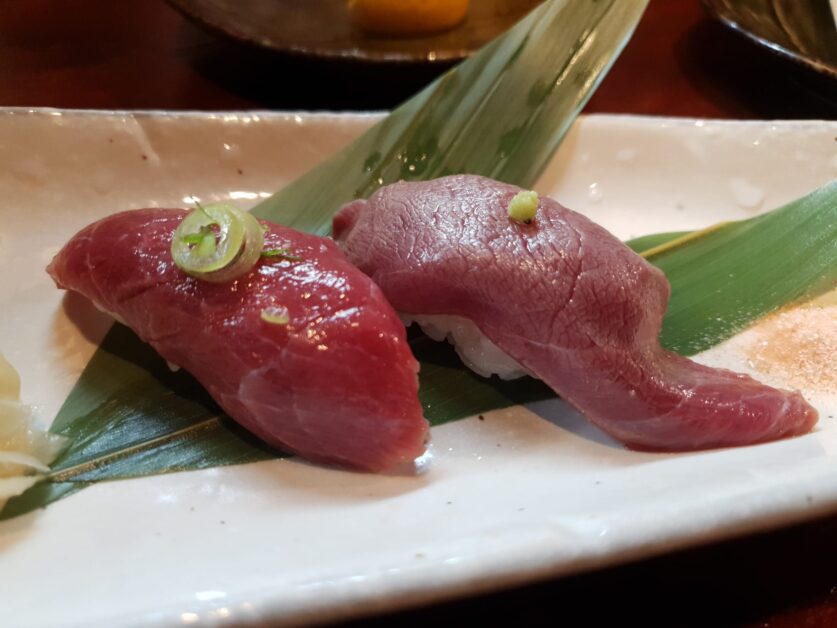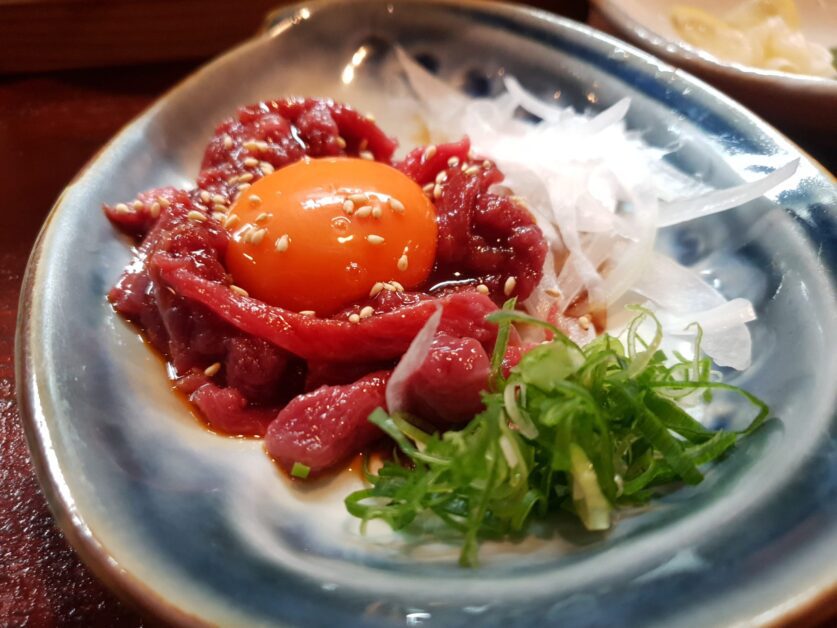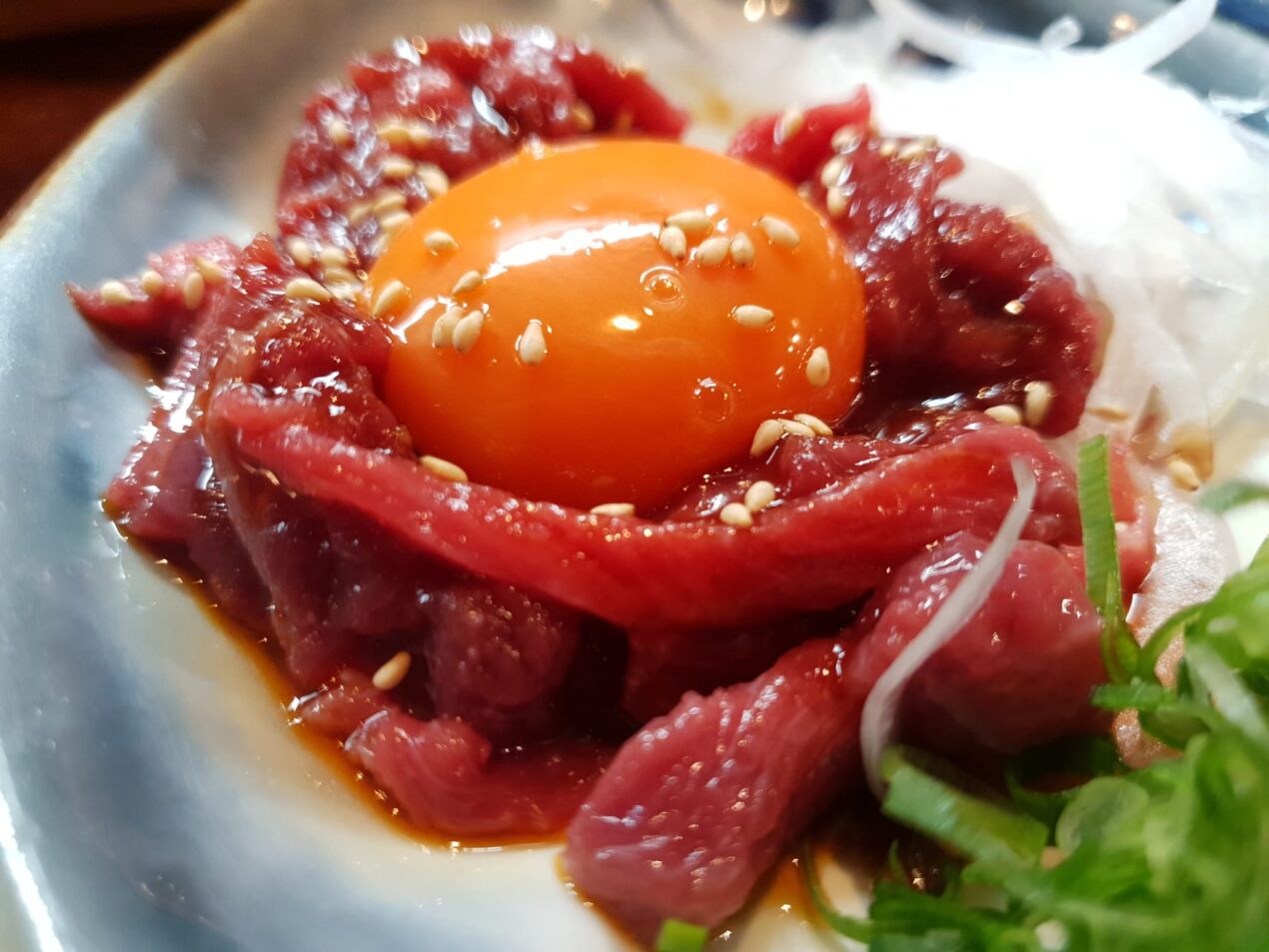Doing the Neigh Neigh at a Horse Meat Restaurant in Osaka
As the dirty South rapper turned murderer ‘Silentó’ of the viral tune and dance craze once sang, “Now watch me whip, whip, watch me nae nae.” As I bounced down the streets of Osaka blaring this banger in my headphones while doing a bit of the stanky leg for good measure, I passed by a restaurant I thought was a popular duck and soba noodle spot. I popped my head into the restaurant, added my name to the registry for the night, and embarked on my daily constitutional (a 5km run around Osaka Castle).
After working up an appetite of one thousand American pygmy shrews (absolutely voracious eaters those little guys are), I returned to the restaurant and took my rightful spot at the bar – overlooking the kitchen. I must have been disoriented from my run and not capable of putting 2+2 together as I saw a Kanji character that I knew all too well. However, it didn’t register and I placed an order for their signature assorted sashimi platter.
Upon arrival, there was something different about it. I couldn’t quite place it. The texture was something I had never seen before. It was such a pinkish hue that even inspector Jacques Clouseau would struggle to solve the mystery behind its coloring. I suddenly caught a laminated placard with a diagram of a horse out of the corner of my eye and I put it all together. “Now watch me whip, whip, watch me neigh neigh,” I whispered under my breath as readied my chopsticks and took my first bite.
Disclaimer: If you are against horse meat consumption, I would probably refrain from reading below. This specifically goes out to you, Kim, the horse girl from my high school who would sometimes nicker and snort to show her excitement. I also imagine this would even extend to those who practice ‘hobby horsing’ where you simulate show jumping with a stick horse.
Trotting to Umaya Tarochan Temmabashi
- Website, Address, & Details: https://kcv9002.gorp.jp/English page
- Restaurant Name: Umaya Tarochan Temmabashi
- Address: 2 Chome-8-3 Tanimachi, Chuo Ward, Osaka, 540-0012, Japan
Let’s get the basics out of the way first. This is an extremely easy spot to get to as it sits right off Tanimachi-suji (Tanimachi street), is on the ground floor, and is easily accessible from the Temmabashi Station or Tanimachi 4-chome metro stop. The entrance also boasts two large inflatable red lanterns and there should be a small menu chalkboard with the characters (馬肉) for horse meat yakiniku (baniku).
It’s a bustling shop that is usually full most days of the week by 8 PM, so I would definitely recommend stopping by earlier in the night to make a reservation (or eat then) or reserving via their website.
You are already going into this way more prepared than I was as you actually know it’s a horse restaurant from the get-go. It also happens to be right near my favorite Yoshinoya ever, which I wrote about in my article: “Why I’m a Yoshinoya Ride or Die For Life,” and right across the street from one of my favorite laptop-friendly cafes to work from – ‘Hara Cafe’. So if you see Yoshinoya’s iconic orange lettering in your pursuit of Black Beauty deconstructed, you’re in the right area.
Pale Ale Travel Tip: The area around Osaka Castle is an absolute slept-on hotspot for food (in my humble opinion). This includes Kitahama, Temmabashi, and Tanimachi 4-chome area. It is the perfect bridge between Namba and Umeda, with plenty of high-quality and affordable restaurants in its crosshairs. If you are staying in the neighborhood (or traveling to Osaka in general) and would like my complete list of restaurants, feel free to reach out to me in the comments, via email, or by shooting me a quick message on Instagram.
Of Course, My Horse!
I never thought I’d say this but horses are absolutely delicious. Where have I been all these years thinking horse meat was only for Floridians and Swedes? Why have I been going to watch the weekly Wednesday horse races at Happy Valley in Hong Kong and not been salivating as thoroughbreds sprinted by with 105-pound jockeys on their backs? Why have I not been putting Seabiscuit on some sea-triscuits and having them as appetizers before Christmas soirees?
As far as I’m concerned, horse is the new beef – and I’m all about that beef horse. While yes, some of these statements are tongue and cheek and may come off as a bit provocative or inflammatory, I’m all for horse meat consumption and would oppose a papal decree outlawing it. That’s not saying it is something I would eat every day but if you are going to eat it, I can’t imagine many better places in the world than Japan.
It’s even rumored that 1986 Kentucky Derby winner ‘Ferdinand’ was not immune from a fate as someone’s dinner and is believed to have been slaughtered in Japan and served to humans or pets.
This isn’t a blog that is set to break down any barriers with compelling arguments advocating for or against the ethics of horse meat consumption. It’s a blog about what I ate, what I drank, and what I enjoyed. Nothing more, nothing less. Sorry, Kim (not an Eminem reference).
Keep in mind that this is a horse meat yakiniku restaurant so you can G.Y.O.H. (grill your own horse) if you so desire. I opted to have all dishes prepared by the chefs as I wasn’t confident in my horse-grilling abilities (I’m still bashful when it comes to grilling horse).
Pale Ale Travel Tip: Are you in Osaka and looking to get your ramen fix? Make sure to check out my guide tackling 21 of the best ramen joints in Osaka.
Horse Sashimi: The Cherry Blossoms of Horse Meat
A fun fact about horse sashimi is that it is commonly referred to as ‘sakura’ (yes, like the cherry blossoms) or ‘sakuraniku’ in Japan due to its strikingly pink color. It’s raw and typically thinly sliced (hence its classification as sashimi), and serviced with soy sauce, onions, garlic, and ginger. For those who want to order it like a pro, this way of serving horse meat is called ‘basashi’ (馬刺し). You’ll see that my plate also has some citrus as well which I find helps break down the fibers of the meat slightly.
The pinkish, white slices that you are looking at are fat from the horse’s neck. This is probably the only thing on the menu that I am ambivalent about. The texture, somewhat velvety, the taste, slightly sweet. Due to it being straight fat, it did melt in the mouth (to some degree) which made a squeeze of the lemon an absolute necessity (to cut through the richness of the fatty flavor).
The dark red slices at the forefront are Akami (I could be wrong with this), leaner cuts of the horse from its hindquarters which make it the firmest of the bunch. Eating the Akami reminded me more of some of the venison I’ve eaten in the past as it was definitely tougher, chewier, and of course, gamier.
This marbled piece is a deep red cut which I personally thought was the best representation of horse sashimi on the platter. It took more of an Ahi tuna-esque texture, with a slightly firmer bite. The flavor was bold, rich, and comparable to an extremely rare steak, which paired nicely with the diced onions and garlic.
One interesting thing I read during my time in Japan is that the darker the horse meat, the older the animal. In Tokyo, I had several platters of horse sashimi which were several noticeable shades darker than this. By my approximation, some of the horses must have been at least 350 years old (I feel like I have to put a disclaimer that I don’t believe there are any horses that have lived to be 350 years old).
My uneducated guess would be that because Umaya Tarochan is a horse meat specialty shop, they are likely able to spring for the younger horses, as the meat was far lighter in color than any other shop I ate at during my Japan-stint. Also, I was mainly throwing back horse sashimi platters at basement izakayas in Tokyo, so I don’t know how effective the transpacific horse meat supply chain is from Calgary to Bakurocho dive bars.
Horse Tataki: Galloping a Fine Line Between Beef & Venison
Horse tataki is almost similar to a rare ribeye as it is gently seared on the outside with a rare center. The quick yet methodical sear caramelizes the natural sugars of the meat and forms a nice little smoky brown crust which is a perfect contrast to the natural sweetness, gaminess, and firmness of the horse meat.
This was the first dish where I started seeing why horse isn’t the big, bad, bland, and scary meat I initially thought it was, as it took a much closer shape to more commonly consumed meats – somewhere between beef and venison. I found the light sear really balanced the flavors and at points yielded almost somewhat of a melt-in-your-mouth type of deal.
With how active horses are, it’s no surprise that horse meat has less fat – some estimates put it at roughly 50% less fat than beef. I think this is why it comes across as the perfect mix of beef and venison, as you get the earthiness and leanness of venison but also the slightly sweet and savory undertones of beef.
Horse Karaage: KFH (Kentucky Fried Horse)
This ain’t the typical karaage that you are used to – this is horse karaage. Coated in a light, crispy batter, horse meat generates far more of a crunch than traditional karaage. I think this is because of the tougher texture of the meat. The karaage at Umaya Tarochan ticked all the boxes of what makes a great piece of fried chicken.
Not overly oily. Check. High-quality horse meat. Check. A batter that complements rather than dominates. Check. An inner juiciness that offers up a tiny explosion of flavor. Check, check, and check.
While the horse karaage was fantastic, I do think that karaage is typically better suited towards white meat like chicken – which is probably why that is the most popular form it takes. Fried beef can sometimes miss the mark for me – except Gyukatsu Motomura (make sure to check out my post on this popular gyukatsu restaurant in Osaka), so I imagine I would eventually run into this if I started mixing more horse karaage into my diet.
Horse Nigiri: From Stable to Sushi Bar

Once again, I’m going out on a hoof (limb) here when I say the left is Akami and Toro is on the right. The darker purple nigiri on the right was far fattier and “meltier in the mouth-er,” while the left was much more reminiscent of the slightly tougher sashimi pictured above.
Both were too easy to eat, especially when served with an accompanying soy sauce and chased with ginger. I think the fact that it was molded over a small ball of rice definitely tricked the mind into thinking it was just a regular piece of sushi as it rounded out the taste a bit more and made it even more familiar than it already was.
Horse Tartare: Umaya Tarochan’s Magnum Opus

I’m saving the best for last here. The horse tartare was the star of the show. I’m a sucker for a great tartare. This tartare was diced (minced? I think it’s too big to be minced) into some fat chunks of sirloin or tenderloin here. Overall, it was a simple and straightforward tartare – which is what I prefer. A light marinade, a hint of citrus, a sprinkle of sesame seeds to add a nice little crunch, and a glowing raw egg yolk on top.
Breaking the egg over the raw meat is always my favorite part. It adds a much-needed rich, creamy texture that acts as the perfect binding agent, allowing you to expertly mix in both the white and green onions and lock in some of that soy sauce flavor.
This blew any steak tartare I’ve ever had out of the water. It was decadence horse-sonified. If there’s one dish you order when you come here, it’s this.
Japan is also great in the way that you don’t need to worry about eating raw egg yolks, as (from what I’ve read) they have developed a rather effective way to not only select and wash eggs but also neutralize and/or decrease the chances of salmonella.
Pale Ale Travel Tip: If all this talk of horse has made you crave some beef, make sure to check out my post breaking down one of my favorite beef katsu sandwiches in Osaka.
I’m unsure if the horse I ate was actually raised in Japan as I later learned (in an izakaya in Tokyo) that the largest exporters of horse meat to Japan are Canada, Mexico, Italy, and several other South American countries.
I’m Not Horsing Around About Umaya Tarochan
Price point-wise, horse meat is higher than beef and pork (and of course chicken), and roughly equivalent to that of veal. My total bill came to just over 10,000 yen for two sashimi platters, two seared horse meat dishes, horse karaage, horse tartare, horse sushi, and about 10 draft beers. I guarantee your bill will be far lower since I can’t imagine many people casually crushing 10 draft beers on a Tuesday night like this Big Body.
I did frequent several other horse meat restaurants during my three-month-stint in Japan and have to say that this was hands down the best of the bunch. Not that the others were of poor quality but it was typically served at an izakaya or other restaurant where the specialty was not horse.
I was surprised at how casual eating horse meat is in Japan. Oftentimes, I’d be at a restaurant with a friend or casually chatting to someone else sitting at the bar (usually my go-to spot as a solo diner), and horse sashimi or horse tartare would make its way in front of me.
As an American, I think it has been somewhat ingrained/hammered into me that eating horse is wrong. However, once you spend time in a country where it’s just another meal and take your first bite, you quickly realize that it’s mostly a mental barrier – because it is damn delicious.
If you did the “neigh neigh” in Japan (or another country where it’s popular), let me know in the comments!
Eat well everyone,
Big Body
Big Body is a voracious lov…eater, a cowardly fighter, and a self-proclaimed curry goat BBQ-eating champion (don’t forget the donkey milk) who likes Stoicism, baseball, and writing in the third person. Having worked for himself for the last 7 years, he isn’t particularly successful but he does still drink ice-cold Sapporo draft beers with the best of them and knows his way around a Dai Pai Dong or two. He is based in Hong Kong but you can still find him in Saigon, Osaka, and Vienna for extended periods.
